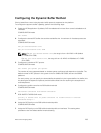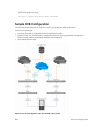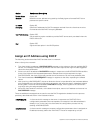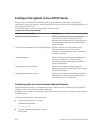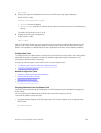
Configure the System to be a DHCP Server
A DHCP server is a network device that has been programmed to provide network configuration
parameters to clients upon request. Servers typically serve many clients, making host management much
more organized and efficient.
The following table lists the key responsibilities of DHCP servers.
Table 21. DHCP Server Responsibilities
DHCP Server Responsibility Description
Address Storage and Management DHCP servers are the owners of the addresses
used by DHCP clients.The server stores the
addresses and manages their use, keeping track of
which addresses have been allocated and which
are still available.
Configuration Parameter Storage and Management DHCP servers also store and maintain other
parameters that are sent to clients when
requested. These parameters specify in detail how
a client is to operate.
Lease Management DHCP servers use leases to allocate addresses to
clients for a limited time. The DHCP server
maintains information about each of the leases,
including lease length.
Responding To Client Requests DHCP servers respond to different types of
requests from clients, primarily, granting, renewing,
and terminating leases.
Providing Administration Services DHCP servers include functionality that allows an
administrator to implement policies that govern
how DHCP performs its other tasks.
Configuring the Server for Automatic Address Allocation
Automatic address allocation is an address assignment method by which the DHCP server leases an IP
address to a client from a pool of available addresses.
An address pool is a range of IP addresses that the DHCP server may assign. The subnet number indexes
the address pools.
To create an address pool, follow these steps.
1. Access the DHCP server CLI context.
CONFIGURATION mode
ip dhcp server
2. Create an address pool and give it a name.
DHCP mode
300
Dynamic Host Configuration Protocol (DHCP)




